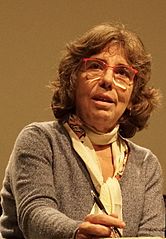This article was published in Scientific American’s former blog network and reflects the views of the author, not necessarily those of Scientific American
On this episode of our podcast My Favorite Theorem, my cohosot Kevin Knudson and I were happy to talk with Michèle Audin, who recently retired from her academic job at the University of Strasbourg and now spends more of her time on literary pursuits. You can listen to the episode here or at kpknudson.com, where there is also a transcript.

Mathematician and writer Michèle Audin. Credit: G.Garitan Wikimedia (CC BY-SA 4.0)
On supporting science journalism
If you're enjoying this article, consider supporting our award-winning journalism by subscribing. By purchasing a subscription you are helping to ensure the future of impactful stories about the discoveries and ideas shaping our world today.
I really enjoyed Dr. Audin’s book Remembering Sofya Kovalevskaya, which I reviewed here, and I was excited we were able to have her as a guest on the podcast. She decided to talk about Stokes’ theorem, also called Stokes’ formula. This theorem is the punchline of multivariable calculus: it relates the value of a function on the boundary of a region to the value of a related function (its derivative) on the entire region. It is a higher-dimensional version of the fundamental theorem of calculus, which was the favorite theorem of our guest Amie Wilkinson on the very first episode of this podcast.
Versions of Stokes’ theorem were originally proved in different applied contexts, and Dr. Audin says one thing she loves about the theorem is the fact that it started in applied mathematics and made its way to pure mathematics instead of the other way around. Recognizing the fact that these seemingly unrelated contexts contained the same mathematics is a neat example of the beauty of mathematical abstraction.
Dr. Audin is interested in math history, and she told us about two of her favorite characters in the story of Stokes’ theorem: George Green, a baker’s son with only a year of formal schooling, who was one of the first people to prove a version of Stokes’ theorem; and Mikhail Ostrogradsky, a Russian military officer who proved a version of the theorem related to water flows. Green’s original essay is available online at arxiv.org. Read more about Ostrogradsky's theorem here.
In each episode of the podcast, we ask our mathematician to pair their theorem with something—food, drink, art, music, or another delight in life. Dr. Audin paired Stokes’ theorem with her novel La Formule de Stokes, Roman (in English, Stokes’ Formula, a Novel). As she describes, she takes a non-chronological look at the history of the formula and some of the mathematicians who were involved with it at various stages. Unfortunately, the novel hasn’t yet been translated into English, but Francophones can find it here.
You can find Dr. Audin at her personal website, her Oulipo page, and her blog about the Paris Commune (all in French). An English language interview with her appeared in the August 2017 Notices of the American Mathematical Society.
You can find more information about the mathematicians and theorems featured in this podcast, along with other delightful mathematical treats, at kpknudson.com and here at Roots of Unity. A transcript is available here. You can subscribe to and review the podcast on iTunes and other podcast delivery systems. We love to hear from our listeners, so please drop us a line at myfavoritetheorem@gmail.com. Kevin Knudson’s handle on Twitter is @niveknosdunk, and mine is @evelynjlamb. The show itself also has a Twitter feed: @myfavethm and a Facebook page. Join us next time to learn another fascinating piece of mathematics.
Previously on My Favorite Theorem:
Episode 0: Your hosts' favorite theorems Episode 1: Amie Wilkinson’s favorite theorem Episode 2: Dave Richeson's favorite theorem Episode 3: Emille Davie Lawrence's favorite theorem Episode 4: Jordan Ellenberg's favorite theorem Episode 5: Dusa McDuff's favorite theorem Episode 6: Eriko Hironaka's favorite theorem Episode 7: Henry Fowler's favorite theorem Episode 8: Justin Curry's favorite theorem Episode 9: Ami Radunskaya's favorite theorem Episode 10: Mohamed Omar's favorite theorem Episode 11: Jeanne Clelland's favorite theorem Episode 12: Candice Price's favorite theorem Episode 13: Patrick Honner's favorite theorem Episode 14: Laura Taalman's favorite theorem Episode 15: Federico Ardila's favorite theorem Episode 16: Jayadev Athreya's favorite theorem Episode 17: Nalini Joshi's favorite theorem Episode 18: John Urschel's favorite theorem Episode 19: Emily Riehl's favorite theorem Episode 20: Francis Su's favorite theorem Episode 21: Jana Rordiguez Hertz's favorite theorem Episode 22: Ken Ribet's favorite theorem Episode 23: Ingrid Daubechies's favorite theorem Episode 24: Vidit Nanda's favorite theorem Episode 25: Holly Krieger's favorite theorem Episode 26: Erika Camacho's favorite theorem Episode 27: James Tanton's favorite theorem Episode 28: Chawne Kimber's favorite theorem Episode 29: Mike Lawler's favorite theorem Episode 30: Katie Steckles' favorite theorem Episode 31: Yen Duong's favorite theorem Episode 32: Anil Venkatesh's favorite theorem
